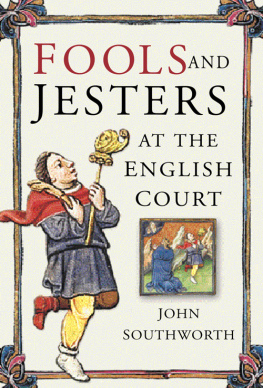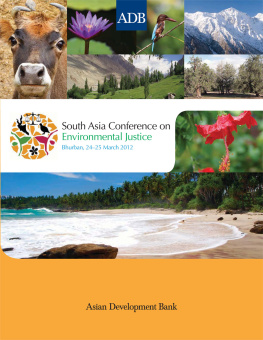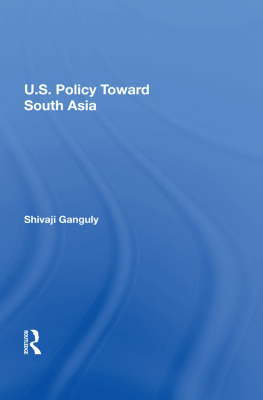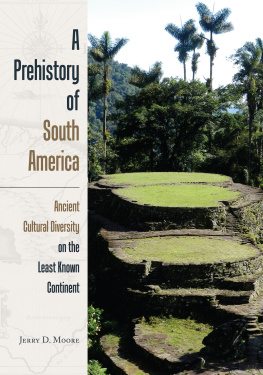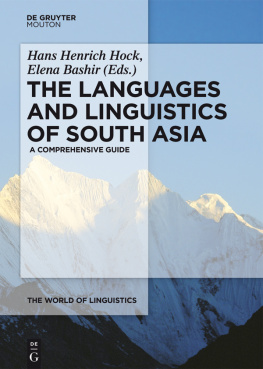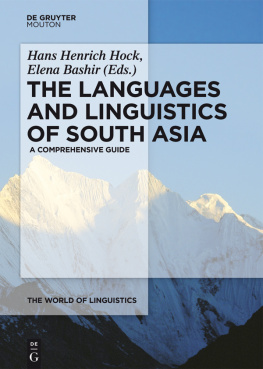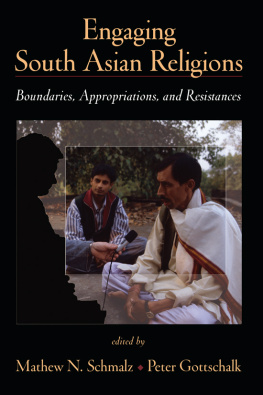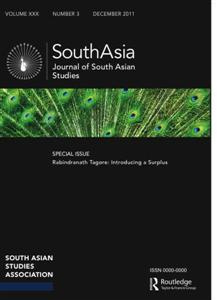1.1. Introduction
As archaeology studies ancient artifacts and attempts to reconstruct a socio-historical context for them, the field I have dubbed linguistic archaeology seeks to reconstruct a sociolinguistic context for ancient linguistic forms, that is, to make inferences from the language of ancient texts and/or linguistic reconstructions about the groups who spoke the language in question including their geographical location, chronology, social and linguistic links with other groups, social stratification, material culture, and ideology. Thus linguistic archaeology can be considered complementary to archaeology itself, in terms of its goals. It also shares with archaeology a commitment to rigorous scholarship, in the sense that conclusions need to be verifiable by methods that are generally agreed upon.
The practitioner of linguistic archaeology draws on assumptions and evidence from five subfields of linguistics:
- historical-comparative linguistics ( 1.2 )
- linguistic palaeontology ( 1.3 )
- sociolinguistics ( 1.4 )
- glottochronology/lexicostatistics ( 1.5 )
- philology ( 1.6 )
The purpose of this chapter is to describe, for the scholar who is not primarily a linguist, the relevant assumptions of these subfields, and the types of evidence which can be derived from them. The process of correlating linguistic and archaeological evidence is discussed in 1.7 .
1.2. Historical-comparative linguistics
Historical linguistics is the diachronic (as opposed to synchronic ) study of language, that is, the study of linguistic change, while historical-comparative linguistics is concerned with the prehistoric inferences that can be drawn from comparison of the forms shared by related languages. (The relevant terms are defined here.)
1.21. Assumptions
The important assumptions of this field which are relevant to the present discussion include the following:
- (A) Accountability : All elements of a language can in principle be accounted for as inheritances, borrowings, or internal innovations ( 1.21A ).
- (B) Change : All linguistic elements are subject to specific types of changes ( 1.21B ).
- (C) Regularity of sound change : Sound change is assumed to act systematically within stateable limits (chronological, geographical, social, and linguistic).
- (D) Reconstructibility : Shared inheritances in related languages allow the reconstruction of corresponding features of a single earlier language from which the related features can be said to be derived. Related languages are those which show resemblances of a type which oblige the investigator to assume that both languages are descended from a single earlier language, that is, that they are historically altered forms of what was once the same language. (See further discussion in 1.22 .)
1.21A. Accountability
A central, though not often explicitly stated, assumption of historical linguistics is that the structural elements of a language (its sounds, lexical forms, and rules of word and sentence formation) can be, in principle, accounted for exhaustively either as (1) inheritances (continuations of previously existing elements), (2) borrowings (elements diffused from a different language or dialect),
- (1) Inherited forms : Marathi pc five (phonetically [pa:ts]) is inherited from Old Indo-Aryan (OIA) paca , which is in turn inherited from a presumed Proto-Indo-European word with a form which may be represented as *penkwe (cf. Latin qunque , Greek pnte ).
- (2) Borrowed forms : HindiUrdu kitb book is originally an Arabic word which entered HindiUrdu through the Persian of the Mughal invaders; Marathi jankan road/rail junction is borrowed from English.
- (3) Internal innovations : (a) Marathi -n in don two (probably on the analogy of tin three, since there is no inherited -n in the Old Indo-Aryan words for two(OIA dvau , HindiUrdu do , etc.); (b) Marathi phaphai motorscooter, motorcycle.
- (4) Inheritance combined with borrowing : Marathi pan you (formal), self, we (inclusive) is inherited from OIA tma(n)- breath, soul, self; however, the meaning we (inclusive) is borrowed from Dravidian (see Southworth 1971; also , note 1).
- (5) Borrowing combined with internal innovation: Marathi jankan (see item)(2)) has a second meaning in colloquial rural Marathi, namely sophisticated, urbane (i.e. one whose sphere of knowledge and acquaintances goes beyond the village level), which appears to be an internal innovation, as in jankan mus [lit. junction man] city slicker, sophisticated man, big shot.
1.21B. Change
- (i) Types of linguistic change . Inherited linguistic forms
- (1) Sound change : For example, consider the following:
- (a) Initial tr- of OIA (Old Indo-Aryan) changed to t- in most MIA (Middle Indo-Aryan) languages. For example, OIA traya three: Pali tayo , OIA trika triple Pali tiko (this is part of a larger sound change; see 1.21C ).
- (b) OIA s (palatal, retroflex, and dental sibilants) merged into s (dental) in most of MIA and NIA (see 6.12A for exceptions in northwestern MIA and NIA; cf. also Bloch 1965: 6874). For example, OIA ata 100: Pali sata , Hindi sau ; OIA satya true: Pali sacca , Hindi sac ; OIA bh speech: Pkt. bhasa ; OIA bhs light: Pkt. bhsa ; OIA na destruction: Pali nsa ; OIA ns nose: Pali ns .
Sound change may result in the loss of a phonological contrast, either in a limited number of environments or all environments (case (b)), the disappearance of a phonological element (e.g. Latin h in the Romance languages, see 1.31 ), the creation of new distinctions (usually secondarily), or the movement of elements in phonological space without any change in the number of contrasting elements such as the change of French /r/ from a tapped [R], still heard in southern French, to a uvular fricative [R] (Chambers and Trudgill 1998), or the changes in the phonetics of vowels in Philadelphia (see 1.41C ).
- (2) Grammatical change : This is defined as change in the underlying system of rules governing grammatical elements. Examples include the following:
- (a) Changes in the order of grammatical elements, such as the changes in word order which occurred between Old English and modern English (compare the following Old English passage and its modern English translation, especially the final clause: Hr on isum are cm nlf and Sween to Lundenbyri on Ntvitas Sancte Mre mid IIII and hundniontium scipum, and h a on a burh festlce feohtende wron Here in this year came Olaf and Svein to London town on the Nativity of St. Mary with four and ninety ships, and they then on the town continuously attacking were.
- (b) Loss of grammatical distinctions, such as the reduction of the declensional system of Latin which occurred in the Romance languages, reducing the forms of the noun from ten (nominative singular stella star, genitive singular stellae , dative plural stells , etc.) to two (singular toile star, plural toiles ).
- (3) Semantic change (i.e. changes involving the meanings which distinguish individual lexical items from each other): for example, OIA bhakta , the past participle of the verb bhaj , originally meant divided, distributed, received, enjoyed, consumed, and later came to mean cooked rice, which is the meaning of the NIA words derived from it (e.g. Bangla and Marathi bht ). Three basic types of semantic change, all of which are especially important for the study of culture history, are given as follows:


